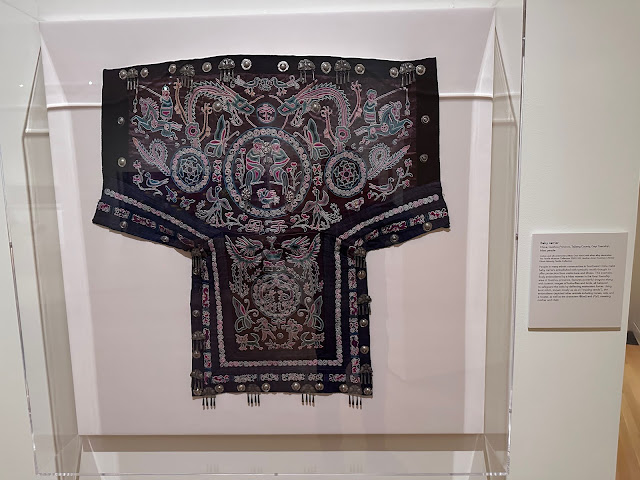Visiting George Washington University's Museum of Textiles was an utter joy! This seems like a really important institution in the textile space. The museum has a wide and rich online catalog as well as several libraries and research spaces within the physical museum.
Textiles 101
While the exhibits were relatively small, they had a room called Textiles 101, which walked through the basics of textile materials, processing, making yarn, weaving, and dying. It was a fantastic introduction to textiles and provided an essential understanding of the space; it was truly a foundational educational experience!
I took photos of basically everything in the museum, and while looking through them, I realized I should have taken a few, wider photos of the main exhibits. Fortunately, the museum of an online version of Textiles 101, so anyone interested should check out this truly phenomenal resource.
Given this online resource, I will just spend some time on a few highlights from the 101 room. The fiber section of the museum shows these images below (which I wish I took a single photo...). The classification of fibers into plants, animals, and manufactured fibers as well as the subclasses was super cool to see.
I didn't realize linen came from the stem of the flax plant, and that fibers can come from the seed, stem, leaf, and bark of plants.
I didn't realize cashmere was goat hair as compared with sheep's wool, which I guess isn't considered hair.
It was also interesting to see the difference between natural polymers like viscose and rayon versus synthetic fibers like nylon and polyester.
Silk has always been one of the more mysterious and alluring fibers for me. It comes from the cocoons of silkworms, and it was so neat to see the cocoons as the little white pods in the middle of this photo. The Chinese first started using silkworms to produce fabric.
Fibers can be classified further as stable fibers, which are shorter and require many smaller fibers to be twisted together to form longer fibers, versus filament fibers, which have a single long thread. Synthetic fibers are usually filament fibers because they are heated and extruded through something that looks like a shower head, where a long fiber comes from each hole. And silk is also a filament fiber because the cocoon is made up of a single thread of silk. CRAZY!
Textiles 101 also had great resources on the color, structure, and decoration of fabrics, which you can read more about here.
The collection
They did have some really lovely garments on display!
This is a stunning embroidered Japanese kimono from the early 1900's. The cranes and turtles represent long lives. In Japan, it is said, "cranes live for one thousand years, and turtles for ten thousand." This Kimono would be worn by women at their wedding reception.
This is a Chinese silk outer robe from the late 19th century. The Cicadas or butterflies on the garmet represent rebirth, long life, and the summer season since they emerge in warm weather.
This silk Chinese vest from Manchu has butterflies representing long life and good fortune. The butterfly pattern was particularly well suited for birthday celebrations.
This cotton and silk embroidered baby carrier comes from the Miao people in southern China in Guizhou province. The dragons, butterflies, and bird imagery is meant to safeguard the baby by deflecting malevolent forces.
This is a book wrap meant to bind Burmese palm-leaf manuscripts. It is called Sazigyo in Burmese. I was delighted to see Burmese in the exhibit!
There was also an exhibit on textiles to decorate animals like horses, camels, and elephants
This decorates a camel and is from Gujarat in northwest India.
An Iranian horse cover.
A Uzbek horse cover. I was so excited to see Uzbeki fabrics! Samarkand has been on my list of places to visit, and I think my more focused interest in fabrics will bring me there sometime soon!
Tibetan saddle cover
Laosian banner featuring elephants, snakes, rhinos, and water buffalos.
Ikat is a dyeing technique where one wraps sections of yarn to prevent the wrapped sections from absorbing the dye. This picture shows an example of the ikat dying approach. The yarn is dyed before it is woven.
Hinggi is an Indonesian ikat fabric made by noblewoman for their kinspeople. In talking about this with my friend, I think I understand why there are certain symmetries in these textiles because the weavers would be able to dye multiple sections of the textiles at the same time because this textile consisted of a single column of pattern repeated throughout the fabric. Moreover, this column pattern is symmetric across the horizontal axis, and perhaps the weavers would double the yarn over itself to make the dying process easier.
An Iranian elephant cover used in India.
This Iranian horse cover was meant to ward off evil. The complex patterns create a labyrinth-like effect and might have been used to confuse the evil eye and protect its wearer.
Quilt exhibition
The museum also had an exhibit on quilts. I was particularly jazzed about seeing some Islamic rugs (of which there were none), so I was honestly a bit disappointed with the quilt exhibit by comparison... I won't go into detail on the quilts but will show a few that I particularly liked.
This charm quilt has a unique pattern for each individual square.
Overall, I had a such a wonderful time at the museum! Now armed with a better understanding of fabrics, I look forward to future endeavors into textiles!



























